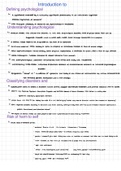Samenvatting
Samenvatting Managerial Economics TEW KUL
- Instelling
- Katholieke Universiteit Leuven (KU Leuven)
Dit document bevat een uitgebreide samenvatting van de cursus 'Managerial Economics' gebaseerd op de slides en lesnota's en verduidelijkt met achtergrondinformatie uit het handboek 'Industrial Organization' door Lynne Pepall, Dan Richards en George Norman.
[Meer zien]













